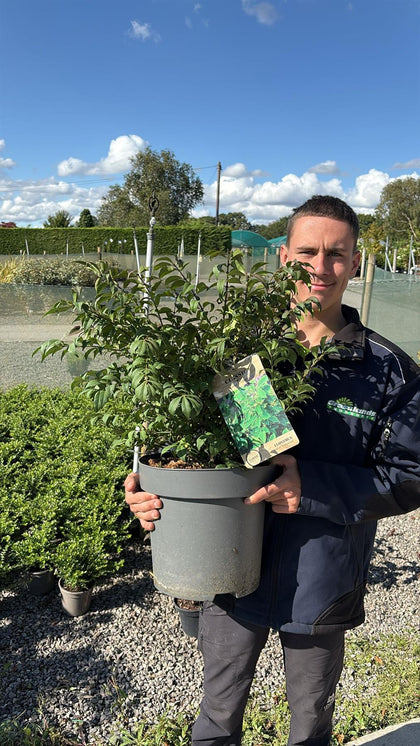Parrotia persica – The Persian Ironwood for Stunning Seasonal Displays and Year-Round Interest
Parrotia persica, commonly known as the Persian Ironwood, is a striking deciduous tree prized for its exceptional ornamental qualities and multi-season interest. With its elegant form, vibrant foliage, and smooth, mottled bark, this tree adds beauty and intrigue to any landscape. Native to Iran, Parrotia persica is well-suited for a variety of conditions, thriving in both formal gardens and naturalistic plantings. Whether used as a specimen tree, in mixed borders, or as part of a woodland garden, the Persian Ironwood is sure to captivate year-round.
Why Grow Parrotia persica?
Spectacular Autumn Foliage – One of the most notable features of Parrotia persica is its breathtaking autumn display. As the cooler months approach, the tree’s green leaves transform into a dazzling array of reds, oranges, yellows, and purples. This vibrant colour change creates a striking focal point in the garden, providing a stunning contrast to evergreen plants.
Year-Round Interest – Beyond its autumn colour, Parrotia persica offers beauty in every season. In spring, it produces clusters of small, spider-like red flowers that add a unique touch to the tree’s appearance. In summer, its glossy green foliage provides a lush, dense canopy. Even in winter, the tree’s smooth, peeling bark creates a captivating texture, offering visual interest when other plants are dormant.
Resilient and Hardy – The Persian Ironwood is known for its resilience. It is highly tolerant of urban conditions, including pollution and compacted soils, and is resistant to most pests and diseases. Its ability to thrive in a wide range of soil types, from slightly acidic to neutral, makes it a versatile choice for many landscapes.
Low Maintenance – Once established, Parrotia persica is easy to care for, requiring minimal attention. It is drought-tolerant and can withstand moderate periods of dryness. The tree's natural shape is tidy and requires little pruning, making it an ideal choice for gardeners seeking a low-maintenance tree with maximum visual impact.
Height and Spread of Parrotia persica
Parrotia persica is a medium-sized tree that typically grows to a height of 6 to 10 meters (20 to 33 feet) and spreads to about 4 to 6 meters (13 to 20 feet) at maturity. Its upright, rounded form makes it a wonderful choice for providing structure in gardens, parks, and woodland settings. Due to its moderate size, it is ideal for medium to large gardens or as a specimen tree in smaller spaces.
Where to Site Your Parrotia persica
This adaptable tree thrives in full sun to partial shade and can be planted in various locations within the garden. Here are some ideal planting settings:
-
Specimen Tree: Parrotia persica is an excellent specimen tree due to its elegant form and year-round interest. It makes a stunning focal point in a lawn or garden bed, where its seasonal displays can be fully appreciated.
-
Woodland Gardens: With its ability to thrive in part shade, the Persian Ironwood is an ideal choice for woodland or shade gardens, where its colorful autumn foliage and unique bark will stand out among other plants.
-
Mixed Borders: Use Parrotia persica in mixed borders to add height and structure. Its rich foliage and dynamic seasonal changes make it an attractive addition to borders with a variety of plants.
-
Urban Gardens: Parrotia persica is tolerant of urban conditions, making it suitable for city gardens or street plantings. Its resistance to pollution and compacted soil ensures it will thrive in more challenging environments.
How to Grow and Care for Your Parrotia persica
Soil – Parrotia persica prefers well-drained, slightly acidic to neutral soil but is adaptable to a variety of soil types, including sandy, loamy, and clay soils. The tree thrives in soils that retain some moisture but are not waterlogged, so good drainage is key.
Light – The Persian Ironwood performs best in full sun to partial shade. It can tolerate some shade, especially in hotter climates, but for the best foliage color and flowering, plant it in a location with access to full sunlight.
Watering – While Parrotia persica is drought-tolerant once established, regular watering during the first few years after planting will help ensure strong growth. During dry periods, water deeply to promote deep root development and prevent the tree from becoming stressed.
Maintenance:
Pruning – Parrotia persica has a naturally attractive form and does not require heavy pruning. Light pruning can be done in late winter or early spring to remove any dead, damaged, or crossing branches. Pruning should be kept to a minimum to preserve the tree’s natural structure and encourage a strong, healthy growth habit.
Mulching – Applying a layer of mulch around the base of the tree helps retain moisture, suppress weeds, and regulate soil temperature. Be sure to keep the mulch a few inches away from the trunk to prevent rot.
Pest & Disease Resistance – Parrotia persica is generally resistant to pests and diseases. It is not prone to common tree issues such as aphids or scale, and it is relatively tolerant of both environmental stresses and urban pollution. However, occasional leaf spot or mildew can be managed with proper care and good air circulation.
Perfect Plant Combinations
Parrotia persica pairs beautifully with a wide range of other plants, adding dynamic color, texture, and height to any landscape:
-
Underplanting with Shade-Loving Perennials: Underplant Parrotia persica with shade-tolerant perennials like Hostas, Heuchera, or Astilbes. These plants will complement the tree’s form and add interest to the lower levels of the garden.
-
Evergreens: Combine Parrotia persica with evergreen shrubs like Boxwood, Juniper, or Pine to create a striking contrast of textures and year-round interest. The evergreen foliage provides a stable backdrop for the tree’s seasonal displays.
-
Spring Flowering Bulbs: Plant early spring bulbs like Crocus, Daffodils, or Snowdrops around the base of the tree. These flowers bloom before the tree fully leafs out, adding a burst of color in early spring.
-
Autumn-Flowering Perennials: Pair Parrotia persica with autumn-blooming perennials like Asters or Japanese Anemone to complement the tree’s colorful fall foliage and extend the season of interest in your garden.
Conclusion
Parrotia persica is a truly remarkable tree that offers year-round beauty, from its vibrant flowers in spring to its stunning autumn foliage and unique bark in winter. With its hardy nature, low-maintenance care requirements, and ability to thrive in a variety of conditions, it is an excellent choice for gardens of all sizes. Whether used as a specimen tree, in mixed borders, or as part of a woodland setting, Parrotia persica adds elegance, structure, and visual interest throughout the seasons. Consider adding this dynamic and beautiful tree to your landscape and enjoy its ever-changing beauty year after year.

 Value pick
Value pick
 Value pick
Value pick
 Value pick
Value pick
 Upgrade
Upgrade
 Upgrade
Upgrade
 Upgrade
Upgrade

